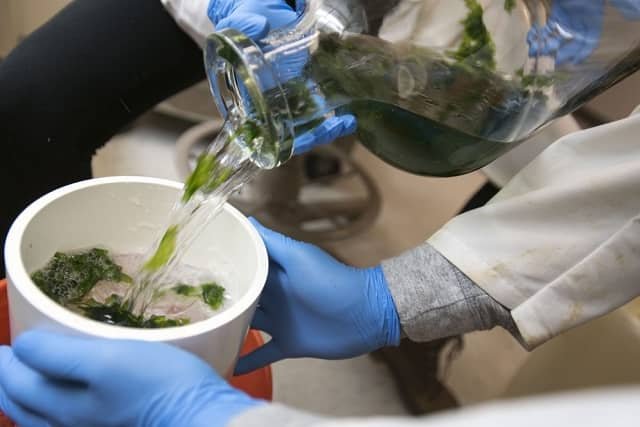USA.- Researchers from UConn and Woods Hole Oceanographic Institution (WHOI) are leading a project that recently secured major funding from the U.S. Department of Energy to boost seaweed farming so that seaweed can be mass produced for expanding markets in biofuel.
The MARINER program (Macroalgae Research Inspiring Novel Energy Resources), a program of the DoE’s Advanced Research Projects Agency-Energy (ARPA-E), awarded $5.7 million to Woods Hole for two projects that develop tools and technology to advance mass production.
Seaweed, primarily used in food and food processing in this country, mainly comes from imported farmed product or wild harvests. Expanding domestic seaweed farming relieves pressure on wild stocks, creates jobs, and revitalizes working waterfronts, say researchers.
“The MARINER program addresses a critical challenge that land production systems are unlikely to solve,” says Scott Lindell, a principal investigator from Woods Hole. “How do we meet growing global biofuel needs and also meet the 50 to 100 percent increase in demand for food expected by 2050? Seaweed farming avoids the growing competition for fertile land, energy intensive fertilizers, and freshwater resources associated with traditional agriculture.”
A major portion of the funding – $3.7 million – will support a team of seaweed biologists, geneticists, and entrepreneurs that will develop a breeding program for sugar kelp – Saccharina latissima, one of the most commercially important species – in hopes of producing plants with a 20 to to 30 percent increased yield over wild plants.
As chief scientist on this portion of the grant, UConn seaweed biologist Charles Yarish, who has a longstanding research program promoting the cultivation of seaweeds in U.S. coastal waters, will develop enhanced tools for the isolation of cultures and establish a world-class germplasm collection (living genetic resources maintained for the purpose of breeding and preservation) of the sugar kelp, Saccharina latissima from the coastal waters of the U.S. This culture collection will enable his UConn team to use both classical breeding technologies and modern genomic tools to select sugar kelp that are best suited to offshore farm environments, are highly productive for use as a bioenergy feedstock, and are also temperature tolerant.
Yarish will provide oversight of the cultivation and nursery systems at UConn and at the National Marine Fisheries Service labs in Milford.
Stay Always Informed
Join our communities to instantly receive the most important news, reports, and analysis from the aquaculture industry.
Other partners in the breeding program are the USDA Agriculture Research Service at Cornell, which will apply DNA sequencing and genomic analysis to direct selective breeding for important traits; and GreenWave, an ocean farming organization headed by Bren Smith, a longtime collaborator with Yarish’s kelp program, which will operate the field trials of the selectively bred families.
The remaining $2 million of the DoE grant will be used by a team from Woods Hole to develop an autonomous underwater observation system for monitoring large-scale seaweed farms for extended periods of time without human intervention.
In a separate project, Yarish and colleagues at the University of Chicago’s Marine Biology Lab, will work with the University of Puerto Rico developing cultivation systems for tropical and subtropical aquaculture of the red seaweed called Eucheuma isoforme.
The ARPA-E estimates that in the U.S. combined brown and red seaweed farming could yield about 300 million dry metric tons per year. When converted to energy, that could fuel about 10 percent of the nation’s annual transportation needs.
As for job creation, a World Bank estimate suggests the farming kelp in less than 5 percent of U.S. territorial waters could create 50 million direct jobs.
Source: UConn Communications
Editor at the digital magazine AquaHoy. He holds a degree in Aquaculture Biology from the National University of Santa (UNS) and a Master’s degree in Science and Innovation Management from the Polytechnic University of Valencia, with postgraduate diplomas in Business Innovation and Innovation Management. He possesses extensive experience in the aquaculture and fisheries sector, having led the Fisheries Innovation Unit of the National Program for Innovation in Fisheries and Aquaculture (PNIPA). He has served as a senior consultant in technology watch, an innovation project formulator and advisor, and a lecturer at UNS. He is a member of the Peruvian College of Biologists and was recognized by the World Aquaculture Society (WAS) in 2016 for his contribution to aquaculture.



